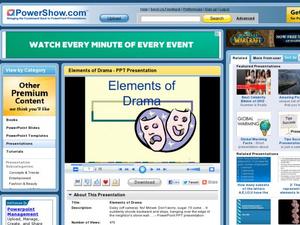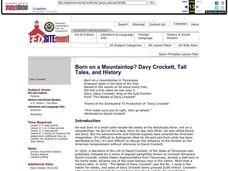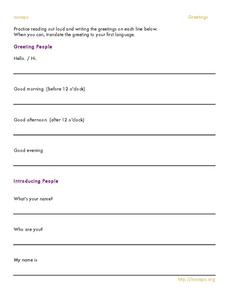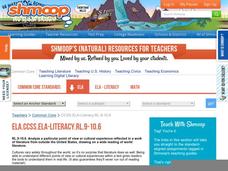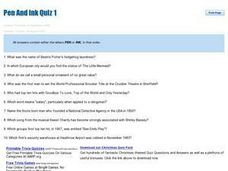Curated OER
No Name Calling
Students use literacy skills to gain information about tolerance. In these lessons on acceptance, student read stories, answer questions, survey students, and plan a citizenship week to encourage participation in a No Name Calling week.
Curated OER
"Name Me Nobody"
Students complete a 3-5 week unit related to the novel "Name Me Nobody." They participate in a literature circle, read and discuss stories provided by the Safe Schools Coalition, complete a Character/Problem-Solution chart, create a...
Core Knowledge Foundation
Unit 1: Contemporary Fiction - They Call Me Güero: A Border Kid’s Poems by David Bowles
They Call Me Güero: A Border Kid's Poems by David Bowles is the focus of a five-week language arts unit unit. Fifth graders listen to various poems and participate in thoughtful discussions, examining vocabulary and learning new words in...
Super Teacher Worksheets
Types of Clouds
What's the term for clouds that look like fluffy cotton balls? What about thick, gray clouds? Learn the names and descriptions for each type of cloud with a worksheet and activity. Learners read four columns of high-level, mid-level,...
Curated OER
Ideas to Spice up Greek and Latin Roots
Learning Greek and Latin roots is an important way to develop vocabulary, but it does get quite boring. Use this list of ideas to add some fun to your daily lessons. Lots of games are suggested to get your kids up and moving. Note: no...
Prestwick House
A Raisin in the Sun
Or does it explode? Discuss the ultimate deferred dream in Lorraine Hansberry's A Raisin in the Sun with a handy crossword puzzle that reviews key names and details from the play.
Curated OER
Elements of Drama: Vocabulary
Introduce your young thespians to the elements of drama! Key vocabulary helps them through their first week of class. The presentation outlines parts of a script, stage direction, and strategies for reading a script. Tip: The strategies...
Curated OER
Email - reading comprehension
In this reading comprehension learning exercise, students label pictures, fill in the blanks to sentences, answer yes or no questions, and more having to do with email. Students complete 8 activities.
Curated OER
Identify the Parts of a Newspaper features of informational text, newspaper format
Young readers make sense out of the wealth of information in newspapers with this helpful reference document. Pointing out basic features like headings, articles, bylines, and captions this resource is a...
Curated OER
Born on a Mountaintop? Davy Crockett, Tall Tales, and History
Students name tall tale characters and locations, which are based on actual people and places, and describe how they are used in an exaggerated way. Students name created characters and events from tall tales. Students write a tall tale.
Read Works
Columbus Was an Explorer
Get the inside scoop on the European explorer, Christopher Columbus, with a response to reading activity that requires scholars to answer who, what, why, when, and a variety of other questions about the word crew.
Nosapo
Greetings
Hi! How are you? Join the conversation with a straightforward exercise on English greetings. After translating common greetings into their first languages, class members practice greeting each other and note the appropriate responses.
Nosapo
Greetings
How do you say hello? In a set of nine greetings practice worksheets, English learners practice saying and writing various phrases in English. Lastly, partners engage in a speaking activity that allows them to practice saying and...
K12 Reader
Fractions as Parts of a Whole
Whether used to introduce learners to fractions or as a comprehension assessment, this two-part, cross-curricular worksheet will give readers a chance to test their understanding of fractions.
Curated OER
Homophone Hunt
What is a homophone? Review the definition with your class before sending them off for this independent activity. As they read the story, they search for any homophones used incorrectly.
English for Everyone
Reading Comprehension: "The Rent Man"
English language learners build their reading comprehension with this passage and its accompanying questions. Before they read the selection, read the questions aloud. Then, as they read, have them mark the text. Twelve multiple-choice...
Shmoop
ELA.CCSS.ELA-Literacy.RL.9-10.6
Being able to identify and understand the point of view of fictional characters across a wide range of time periods, places, and cultures is a skill that is necessary for becoming a proficient reader. It is also a skill identified in the...
Curated OER
Stereotype Characters Activity
Here is a lesson designed for middle schoolers which helps them recognize stereotypes one way or another against a particular group of people. They also determine what may have motivated the author to use a stereotype in the first place....
Curated OER
April Fools Web Quest
How much does your class know about the history of April Fools Day? They'll use the Internet and five great questions to uncover the history and origin of this very silly holiday. Two web links are included, to make hunting for answers...
Curated OER
Pen and Ink Quiz 1
In this pen and ink activity, students answer short answer questions where the answers contain either the words pen or ink. Students complete 10 short answer questions.
Curated OER
Thanksgiving Traditions
Everyone celebrates traditions in different ways. Young writers share the ways their families celebrate Thanksgiving with a journal writing prompt and discussion activity.
Curated OER
It Started as an Egg
Learners investigate animals that hatch from eggs. In this hatching animals lesson plan, students investigate which animals are born alive and which hatch from eggs. Learners read It Started As An Egg and practice reading comprehension...
Curated OER
Writing with Commas
In this grammar activity, students read and correctly supply the commas where they are needed in twenty sentences. Students place a C in the space provided if the sentence is correct as is.
Curated OER
Quiz 5A: Irregular Verbs (Group 3)_
In this irregular verbs worksheet, students write the past tense of 12 verbs and then use them to complete 9 sentences. These will be irregular verbs.






